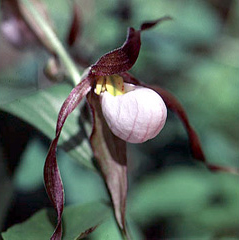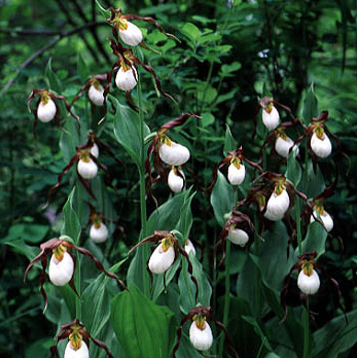On 30 June 1805, after another brush with death above Montana’s Lolo Creek, Lewis noticed a flower: “in shape and appearance like ours”—in Virginia, of course—”only that the corolla is white, marked with small veigns of pale red longitudinally on the inner side.” He might also have remarked upon its three twisted sepals, flung back carelessly like big bold brunette dreadlocks.
Since the plant didn’t seem to be a new species—although it really was—he didn’t collect a specimen. Apparently he pointed one out to Clark two days later at Travelers’ Rest, for Clark copied Lewis’s brief identification of it verbatim except for a postscript—”and much smaller.”
Its scientific name is Cypripedium montanum Dougl. The genus name, Cypripedium, is a combination of Cypris, which is the Latin name for “Venus”; and pedium, “foot.” The specific epithet, montanum, means “mountain.” Although other members of this genus have been transplanted far and wide, the species montanum is at home only in the northern Rockies, and even there is rare today. Several of its botanical features identifiy it with the orchid family.
Experience the Lewis and Clark Trail
The Lewis and Clark Trail Experience—our sister site at lewisandclark.travel—connects the world to people and places on the Lewis and Clark Trail.
Discover More
- The Lewis and Clark Expedition: Day by Day by Gary E. Moulton (University of Nebraska Press, 2018). The story in prose, 14 May 1804–23 September 1806.
- The Lewis and Clark Journals: An American Epic of Discovery (abridged) by Gary E. Moulton (University of Nebraska Press, 2003). Selected journal excerpts, 14 May 1804–23 September 1806.
- The Lewis and Clark Journals. by Gary E. Moulton (University of Nebraska Press, 1983–2001). The complete story in 13 volumes.



